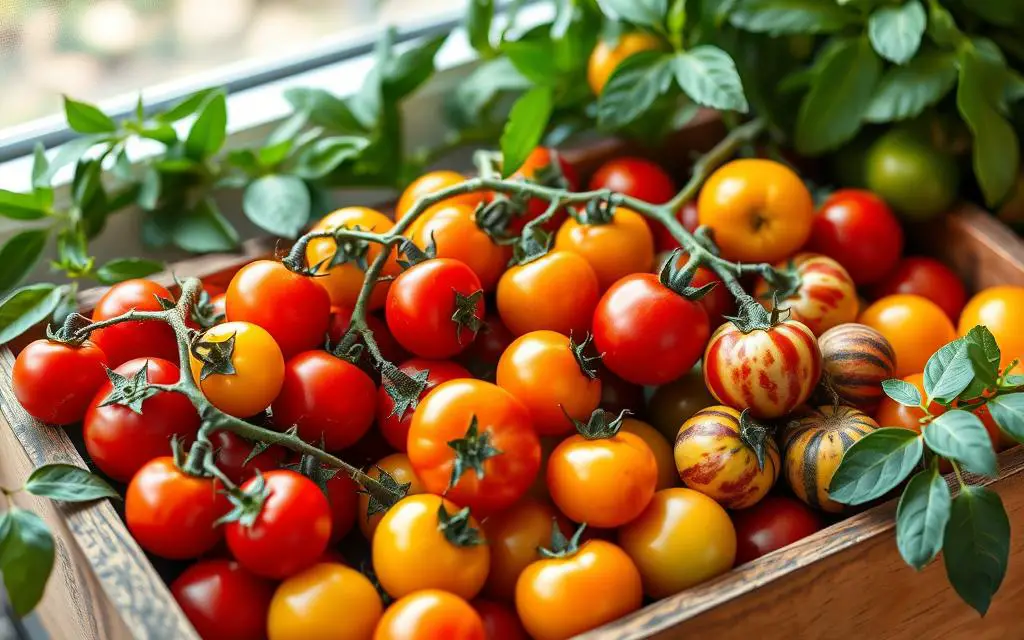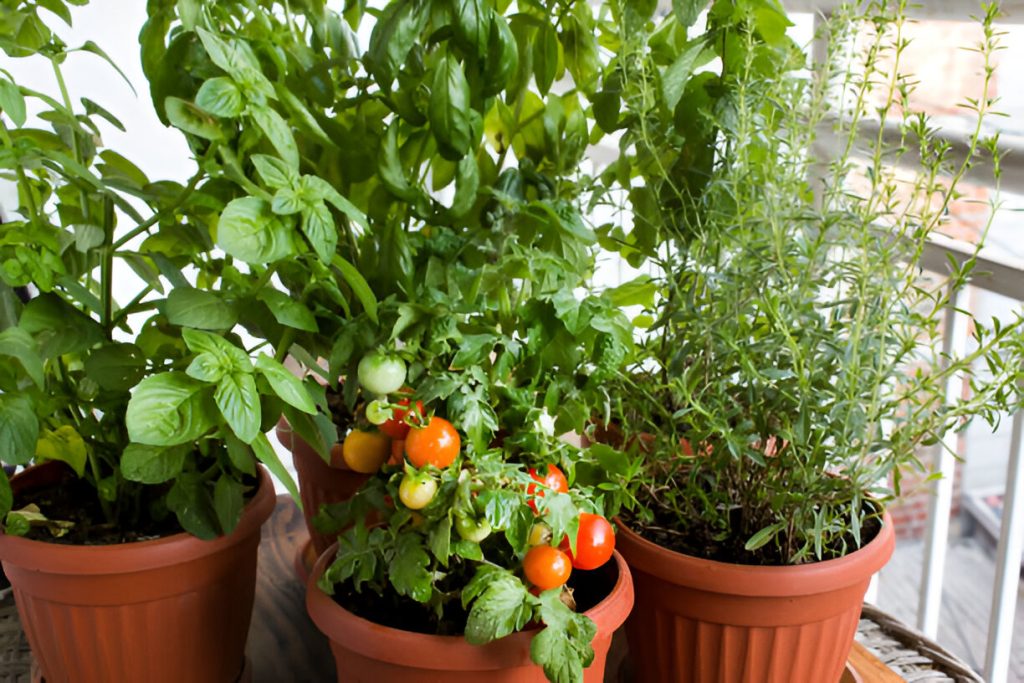Ever dreamed of having juicy, flavorful cherry tomatoes all year? Growing them indoors could be the answer. This guide will show you how to grow a successful crop of cherry tomatoes indoors. You’ll learn how to make the most of your living space for gardening.
But first, have you thought about growing cherry tomatoes indoors for year-round flavor? Indoor gardening lets you enjoy these tasty fruits anytime you want. It breaks free from the limits of the growing season.
Key Takeaways
- Discover the secrets to growing flavorful cherry tomatoes indoors year-round
- Learn about the advantages of indoor cherry tomato gardening, including an extended growing season and a controlled environment
- Explore the best cherry tomato varieties for indoor cultivation and how to set up your growing space for success
- Understand essential techniques like pruning, training, pollination, and pest management to ensure a bountiful harvest
- Gain tips on harvesting and storing your indoor-grown cherry tomatoes to enjoy their freshness and flavor
Advantages of Growing Cherry Tomatoes Indoors
Growing cherry tomatoes indoors has many benefits over growing them outside. One big plus is the longer growing season. You can have a harvest all year, not just during the outdoor growing season.
Extended Growing Season
Indoor gardening lets you grow cherry tomatoes longer. You can control the temperature, humidity, and light. This makes for healthy plants and lots of fruit, even when it’s cold outside.
Controlled Environment
Indoor gardening gives you an edge when growing cherry tomatoes. You can set the climate just right. This means your plants get the perfect amount of sunlight, warmth, and moisture.
Dwarf tomato varieties like the Tiny Tim are great for indoor gardens. They don’t get taller than two feet. With proper care, you can have fresh, tasty cherry tomatoes all year, no matter the weather.
Setting Up Your Indoor Growing Space
Growing cherry tomatoes indoors is rewarding but needs the right setup. You must think about grow lights, containers, and soil for your plants to thrive.
Cherry tomatoes need 8 to 12 hours of light daily. If your space lacks enough sunlight, use grow lights. Choose high-quality LED or fluorescent lights for the best plant growth.
The size of your containers matters too. Keep each cherry tomato plant in a 12 to 14-inch (31-36 cm) pot. Use a special soil mix for containers or tomatoes that drains well and is rich in nutrients. Don’t use regular garden soil, as it’s too dense.
For a low-maintenance option, consider a hydroponic system. These systems control the plant’s nutrients and water, leading to quick growth and lots of tomatoes. But, they cost more and need more upkeep than traditional gardening.
Make sure your growing space has good air flow to prevent diseases and help with pollination. With the right setup, you’ll enjoy a great indoor cherry tomato harvest.
“Growing cherry tomatoes indoors provides the opportunity to enjoy fresh, flavorful produce year-round, even in colder climates.”
Choosing the Right Cherry Tomato Varieties

Choosing the right cherry tomatoes is key to success in indoor gardening. You should look at growth habits, fruit size, color, and flavor. This helps you pick the best ones for your space and taste.
Indeterminate cherry tomatoes grow more and produce fruit for a long time. Determinate plants are bushy and give one big harvest. Knowing these differences can help you pick the best for your indoor garden.
Here are some top cherry tomato varieties to consider:
- Amish Salad
- Camp Joy
- Galinas
- Green Grape
- Hawaiian
- Peacevine Cherry
- Riesentraube
- Snow
Cherry tomatoes are sweet and juicy, with unique flavors. They have a sweetness rating from 5 to 12. Some heirlooms like Black Cherry and Matt’s Wild Cherry score up to 9.
| Variety | Brix Rating | Flavor Profile |
|---|---|---|
| Black Cherry | 9 | Rich, complex, sweet, slightly tangy, and smoky |
| Blondkopfchen | 8 | Sweet and fruity with a touch of citrusy tang |
| Green Envy | 8 | Sweet and fruity with a hint of tartness |
| Matt’s Wild Cherry | 9 | Tangy, slightly sour, and sweet |
There are over 700 tomato varieties to choose from. By learning about different cherry tomatoes, you can pick the best ones for your indoor garden. This way, you can enjoy your favorite flavors.
Indoor Cherry Tomato Gardening
Growing cherry tomatoes indoors can be rewarding. It needs careful attention to the right growing conditions. Understanding the plant’s soil, watering, fertilizer, and sunlight needs is key.
Cherry tomatoes do well in slightly acidic, well-draining soil rich in organic matter. The right soil is crucial for their health and productivity.
Watering indoor cherry tomatoes is important. Too much water can cause diseases, but the right moisture is key. Water them once or twice a day as they grow and produce fruit.
Using a fertilizer high in phosphorus and potassium helps with growth and fruiting. A balanced, nutrient-rich fertilizer can greatly improve your tomato crop.
Cherry tomatoes need enough sunlight to grow well. They need at least six hours of light daily, with eight hours ideal. If there’s no natural light, grow lights can help.
By focusing on these conditions, gardeners can enjoy a great indoor cherry tomato harvest at home.
| Ideal Growing Conditions for Indoor Cherry Tomatoes | Specification |
|---|---|
| Soil Requirements | Slightly acidic, well-draining, rich in organic matter |
| Watering Needs | Once or twice daily, especially as plants mature |
| Fertilizer | High in phosphorus and potassium |
| Sunlight Requirements | Minimum of 6 hours per day, with best results at 8+ hours |
“Indoor cherry tomato plants have the potential to grow up to 7 feet tall, showcasing their impressive size and productivity when provided with the right growing conditions.”
Pruning and Training Techniques
Proper pruning and training can greatly improve your indoor cherry tomato plants. By removing suckers, the plant puts more energy into making tasty fruit. Using trellises or cages lets the plants grow up, which helps with air flow and uses space well. This way, the plants make more fruit instead of just leaves.
Removing Suckers
Pruning tomato plants is a way to keep them neat and help the fruit grow bigger and ripen faster. It’s best for indeterminate tomatoes that keep growing all season. By pruning, the plant uses its energy for making fruit, not just leaves.
Trellising and Caging
Pruning helps with air flow between stems, which stops diseases from spreading. Diseases like late blight and fusarium wilt can harm tomato plants. Pruning makes the plant focus on making fruit, leading to bigger and riper tomatoes, especially in short seasons.
| Pruning Technique | Benefit |
|---|---|
| Removing Suckers | Redirects energy to fruit production |
| Trellising and Caging | Improves air circulation and maximizes growing space |
“Proper pruning and training techniques can make a significant difference in the health and productivity of your indoor cherry tomato plants.”
Indoor Pollination Methods
Growing cherry tomatoes indoors has its own set of challenges. Ensuring successful pollination is a key task. Since indoor plants don’t get natural pollination like wind or insects, you must help them out.
Hand pollination is a great way to do this. Use a soft brush or your finger to move pollen from the flower’s base to the stigma in the center. This helps your indoor cherry tomato plants produce lots of fruit.
Or, you can use a small electric fan to help pollinate your plants. The fan’s air movement can spread pollen to the stigma, helping with fruit set.
Doing these pollination methods often, by hand or with a fan, is key for your plants. Be patient and gentle to get a good crop of cherry tomatoes.
| Pollination Method | Description | Advantages |
|---|---|---|
| Hand Pollination | Using a soft brush or finger to manually transfer pollen from the flower’s base to the stigma | Mimics natural pollination, ensures successful fruit set |
| Electric Fan | Using a small electric fan to create gentle air movement around the flowers | Simulates natural wind pollination, promotes pollen transfer |
“Being patient and gentle during the hand-pollination process is essential for successful indoor plant growth and fruit production.”
The Importance of Pollination
Proper pollination is key for your indoor cherry tomato plants’ health and productivity. Without it, your plants might not set fruit well, leading to fewer tomatoes. Using hand pollination or an electric fan can help ensure your plants get the pollination they need.
Pest and Disease Management
Growing cherry tomatoes indoors can be rewarding, but watch out for pests and diseases. Whitefly infestations can spread the tomato yellow leaf curl virus. Also, be aware of fungal diseases like buckeye rot and bacterial diseases.
Good growing conditions help prevent many problems. This includes proper air flow and avoiding too much moisture. Regularly check your plants and act fast if you see issues. Use insecticidal soaps or fungicides as needed.
Bacterial Wilt
- Bacterial wilt (Ralstonia solanacearum) causes a rapid wilting of tomato plants.
- Prevention & Treatment: Rotate with non-susceptible plants like corn, beans, and cabbage for at least three years.
- Recently, bacterial wilt resistant rootstocks for grafted tomatoes, peppers, and eggplants have been tested and found to have a high level of resistance.
Early Blight
- Early blight (Alternaria linariae) is caused by the fungi Alternaria linariae.
- Prevention & Treatment: Use resistant or tolerant tomato cultivars. Chemical control options include mancozeb, chlorothalonil, or copper fungicides.
Understanding pests and diseases that affect indoor cherry tomatoes helps you prevent and manage them. Being vigilant and acting quickly keeps your indoor tomato garden healthy and productive.
Indoor Cherry Tomato Gardening
When growing cherry tomatoes indoors, you have several options for your setup. Container gardening with pots or raised beds is great for small spaces. These setups let you control the soil and provide the right sunlight requirements, using natural or grow lights. It’s key to give your plants enough space considerations and the right conditions for lots of fruit.
Indoor tomato plants need 18 to 22 hours of extra light each day. Patio or bush tomatoes are perfect for indoor growing, giving you cherry, grape, Roma, and small slicer fruits. Starting seeds in a warm spot can speed up germination in just a few days.
Move seedlings to bigger containers when they’re 6 inches tall. They should go into containers that are at least 14 inches wide and 20 inches deep. The best temperature for growing tomatoes indoors is between 70 and 80°F. These plants need water every day to check their moisture levels. Regular feeding helps replace nutrients lost from watering.
| Key Considerations for Indoor Cherry Tomato Gardening | Details |
|---|---|
| Lighting Requirements | 18 to 22 hours of supplemental light per day |
| Suitable Tomato Varieties | Patio or bush tomato varieties, producing cherry, grape, Roma, and small slicer type fruit |
| Seed Germination | Accelerated germination (2-3 days) with heat under seed trays |
| Transplanting Seedlings | Transplant when 6 inches tall to containers at least 14 inches wide and 20 inches deep |
| Temperature Range | 70 to 80°F |
| Watering and Fertilization | More frequent watering and regular fertilization required |
Tomatoes pollinate themselves but get a boost from daily plant shaking. Turning the plants helps them grow strong and spread out. Using bamboo stakes and cloth ties can support plants with weak stems when they’re heavy with fruit.
It takes about 60 to 80 days for indoor tomatoes to produce fruit, similar to outdoors. They need eight hours of sunlight a day indoors. Seeds take five to 10 days to germinate, and plum and cherry tomatoes are quick to ripen.
“Proper space is essential for indoor tomatoes as they grow larger, requiring stakes to hold vines in place and bigger pots as they outgrow current ones.”
Harvesting and Enjoying Your Indoor Cherry Tomato Crop
The reward for growing indoor cherry tomatoes is the delicious harvest. These small fruits are ready to pick in 50 to 65 days after planting. They turn their full color when they are ready. For the best taste, pick them when they are a bit underripe. They will keep getting sweeter after being picked.
When to Harvest
You’ll know your cherry tomatoes are ready when they:
- Have a deep, rich color (red, yellow, or orange, depending on the variety)
- Feel slightly soft to the touch, but not mushy
- Easily separate from the vine with a gentle tug
Don’t wait for the tomatoes to ripen fully on the vine. They will get sweeter and taste better after being picked.
Storing Fresh Cherry Tomatoes
After picking, store your cherry tomatoes in the fridge for a few days. But, they won’t taste as good as when they were fresh. To keep them fresh, put them in a single layer in a shallow container. Cover them with a damp paper towel to keep them moist and prevent them from drying out.
These tomatoes are great for many dishes, like salads, sauces, roasted, or sautéed. Their bright colors and sweet taste make any meal special. Enjoy the fruits of your hard work and the unique flavors of your indoor cherry tomatoes!
Troubleshooting Common Issues
Even with careful attention, you may face some common issues when growing cherry tomatoes indoors. Fruit cracking can happen due to fluctuations in temperature and moisture levels. These can be hard to control indoors. Also, problems like overwatering, underwatering, and nutrient deficiencies can affect your plants’ health and how well they produce.
Keep a close eye on your plants to spot and fix these problems. Adjusting how you water, control the temperature, and manage nutrients can help. This can lead to a successful indoor cherry tomato harvest.
Preventing Cracking and Blossom-End Rot
Fruit cracking is often caused by temperature fluctuations and uneven watering. Keep the temperature steady between 70-80°F and make sure the soil is consistently moist. Also, having enough calcium in the soil can stop blossom-end rot, a common issue with cherry tomatoes.
Addressing Nutrient Deficiencies
Yellow leaves, slow growth, and fewer fruits can mean your plants lack nutrients. Regularly feeding your indoor tomato plants with a balanced fertilizer can help. This ensures they get the minerals they need to grow well.
Controlling Pests and Diseases
Indoor plants can be at risk of pests and diseases. Watch for signs of aphids, tomato hornworms, or fungal infections like early blight or late blight. Use organic or chemical treatments quickly to stop these problems.
By keeping an eye on your plants and making changes as needed, you can beat the common challenges of indoor cherry tomato gardening. This way, you can enjoy a great harvest.
“The key to success in indoor cherry tomato gardening is being proactive and responsive to your plants’ needs. With a little troubleshooting, you can overcome even the toughest growing challenges.”
Conclusion
Growing cherry tomatoes indoors is a rewarding way to enjoy tasty fruits all year. By creating the right growing conditions and picking the right indoor gardening varieties, you can have a great indoor cherry tomatoes garden. Even in small spaces, with a bit of care, you can enjoy the sweet and tangy taste of homegrown flavorful produce.
Tomatoes are full of vitamins, minerals, and antioxidants. Growing your own cherry tomatoes means you always have fresh fruits. It also helps reduce your carbon footprint and gives you more access to year-round harvest of this favorite food.
Whether you’re a pro at gardening or just starting, growing your own indoor gardening cherry tomatoes is special. So, take the chance to make a space for these lovely fruits. Enjoy the happiness of picking your own flavorful produce.
Source Links
- 8+ Easy Tips for Growing Cherry Tomatoes Indoors
- How to grow hydroponic cherry tomatoes Indoors: A Detailed Guide
- Growing Tomatoes Indoors: Year-Round Fruit
- How To Grow And Care For Cherry Tomatoes
- Indoor Cherry Tomato Growing – Tips For Indoor Cherry Tomatoes
- How to Grow Cherry Tomatoes Indoors – The Vegan Atlas
- A Complete Guide to Growing Cherry Tomatoes – Fine Gardening
- The Best-Tasting Cherry Tomatoes
- How to Choose Tomato Plant Varieties | Gardener’s Supply
- Yes, You Can Grow Tomatoes Indoors—Expert Gardeners Explain How
- Moving Tomato Plant Inside — Gardening Charlotte
- How To Prune Tomato Plants
- Tomato Pruning Techniques 🍅 How to Prune Tomatoes
- How to Pollinate Tomatoes in 3 Steps
- How to Pollinate Indoor Tomatoes, Cucumbers, Squash and Other Plants
- Tomato Diseases & Disorders
- If you have questions about tomato diseases and pests TomatoFest has the answers to insure you an abundant tomato harvest.
- 16 Pests & Diseases That Can Kill Your Greenhouse Tomato Plants
- 10 Must-Know Tips for Growing Tomatoes Indoors
- Grow Tomatoes Indoors – Jobe’s Company
- How to move your favorite tomato plant indoors for the winter
- How to grow hydroponic cherry tomatoes Indoors: A Detailed Guide
- 23 Common Tomato Plant Problems and How to Fix Them
- Troubleshooting Tomato Problems, Tomato Pests | Gardener’s Supply
- Complete Guide for Successfully Growing Tomatoes Indoors
- Popular Benefits of Growing Tomatoes at Home
- How to grow hydroponic cherry tomatoes Indoors: A Detailed Guide
- Growing Tomatoes Indoors: Must-Know Tips







